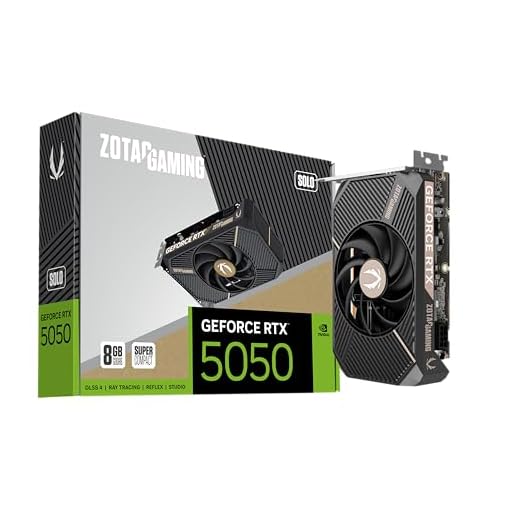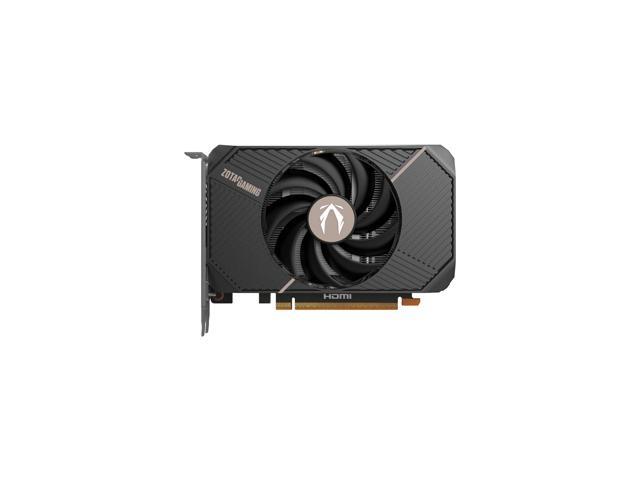Conclusion
NVIDIA has launched the GeForce RTX 5050, which completes the GeForce RTX 50 Series lineup for 2025, from the high-end to the low-end. The GeForce RTX 5050 at $249 is the entry-level GeForce RTX 50 Series Blackwell GPU from NVIDIA; right above it sits the GeForce RTX 5060. NVIDIA did not have a previous generation (GeForce RTX 40 Series) GPU at the $249 price point. There wasn’t a “4050” GPU for desktop DIY on the PC. Therefore, the GeForce RTX 5050 replaces the GeForce RTX 3050 (GeForce RTX 30 Series), which launched in 2022 for $249. In that sense, the GeForce RTX 5050 constitutes an upgrade to a 4-year-old GPU, and two generations newer.
The GeForce RTX 5050 utilizes the GB207 die, and has 20 SMs, 2,560 CUDA Cores, 20 RT Cores, 80 Tensor Cores, 32 ROPs, and 80 Texture Units. It has the benefit of using 4th Gen RT Cores and 5th Gen Tensor Cores compared to the GeForce RTX 3050’s 2nd Gen RT Cores and 3rd Gen Tensor Cores. The GeForce RTX 5050 runs at a GPU Boost of 2572MHz, much faster than the GeForce RTX 3050’s 1777MHz. The GeForce RTX 5050, while also having 8GB of GDDR6 VRAM like the RTX 3050, uses faster VRAM at 20Gbps compared to 14Gbps, giving it 320GB/s of bandwidth compared to 224GB/s on the RTX 3050. The TDP, though, is the same between the two at 130W, showing a marked improvement in performance per Watt and efficiency with the RTX 5050.
Performance
In our review of the GeForce RTX 5050 GPU today, we focused on a GPU family review of the RTX 5050, and to represent it, we used custom manufacturer video cards. The video cards used were: ZOTAC GAMING GeForce RTX 5050 SOLO (purchased by us), GIGABYTE GeForce RTX 4060 OC Low Profile 8G, PNY GeForce RTX 3050 8G VERTO Dual Fan, and AMD Radeon RX 7600 reference. This review had a focus on low-profile, or compact, video cards based on these GPUs. We focused on the 1080p gameplay experience in 11 games, testing average FPS, 1% Lows, Native Resolution, DLSS Upscaling, and Ray Tracing performance.
Looking at Native Resolution across 11 games, we wanted to find out if the GeForce RTX 5050 could muster the highest game settings at 1080p. We found very mixed results, but most of the results lean towards this not being the norm. In other words, we mainly had to lower in-game quality settings at 1080p to get a playable experience in modern games on the GeForce RTX 5050, with Ultra or Epic settings not being a viable option at Native Resolution. Alan Wake 2 was borderline playable at High, but really, to get the 1% Lows up, we had to drop to Medium. Black Myth: Wukong was also only playable on Medium at 1080p. Cyberpunk 2077 was pretty much the only game that was playable on Ultra, else every other game had to be lowered to at least Medium. Some new games, like Mafia: The Old Country, weren’t even playable on Low, however.
When we enabled DLSS Upscaling at Quality Mode, this allowed most games the ability to turn the graphics settings up one notch from Medium. However, there were still some games that, to keep the 1% Lows at 60FPS, we had to keep them at Medium settings. Some games, though, DLSS Upscaling was required just to make it playable. DLSS Upscaling at 1080p isn’t the best for image quality, of course, but in this case, the GeForce RTX 5050 does support DLSS 4 Transformer Model, so it does have the best quality available to it. With the GeForce RTX 5050, DLSS Upscaling is more of a reality than not, even at 1080p in some of these modern, newer games. You’ll find yourself enabling it to get the smoothest gameplay.
When it comes to Ray Tracing, you can pretty much forget it with the GeForce RTX 5050. Some games have ‘ray tracing’ enabled by default, and enabled at all times, so some games this is a native feature anyway, especially with UE5’s Lumen. These games are demanding, and that is why they require you to turn down the graphics settings. Some older games, though, like Cyberpunk 2077, are actually playable with Medium Ray Tracing and DLSS Upscaling enabled at 1080p, so this is going to depend on the game’s implementation of Ray Tracing and features available.
When it comes to the performance of the GeForce RTX 5050 as an upgrade to the GeForce RTX 3050, it can be a pretty major one. We are seeing performance is anywhere from 50% faster up to 80% faster than the GeForce RTX 3050 in raster performance, native resolution. We are also seeing that in games with always-on ray-traced lighting, or with extra ray tracing features, the GeForce RTX 5050 takes a bigger lead in performance, showing an RT performance improvement from the RTX 3050 series. One interesting thing we also discovered was that DLSS Ray Reconstruction seems to be faster on the GeForce RTX 5050 compared to the GeForce RTX 3050, showing bigger gains with Upscaling and Ray Reconstruction enabled on the RTX 5050.
Looking at the comparison to the GeForce RTX 4060, it is a mixed bag. At times, the GeForce RTX 5050 is on par with the GeForce RTX 3050, and at other times it is up to 10% slower. It does depend on the game and the settings used. The two video cards are very close, and one could almost say the GeForce RTX 5050 is a replacement for, or matches, the GeForce RTX 4060 from the last generation. In other words, the GeForce RTX 5050 is almost the GeForce RTX 4060 at a lower MSRP ($249, compared to $299), meaning the RTX 5050 offers RTX 4060 performance for a cheaper price now. However, there can still be a 10% performance difference, so it isn’t exactly that, but close.
When we compare the GeForce RTX 5050 to the Radeon RX 7600, we actually find that the GeForce RTX 5050 is typically much faster. In the cases of ray-traced global illumination games, the GeForce RTX 5050 has a huge leg up on performance. There are some games where the Radeon RX 7600 is closer to the GeForce RTX 5050, but overall, the GeForce RTX 5050 offers better performance at a lower MSRP. In addition, the GeForce RTX 5050 has DLSS 4 Transformer Model Upscaling, while the Radeon RX 7600 does not have FSR 4 support, only FSR 3. Therefore, the GeForce RTX 5050 has better Upscaling image quality.
Final Points
We started this review out by asking: Is the NVIDIA GeForce RTX 5050 a game-changer at $249 MSRP? We wouldn’t call it a game changer, but we would say it is a big upgrade from a GeForce RTX 3050, and also offers a good value at $249 with the features and performance from the RTX lineup. In order for this to have been a “game changer,” in our opinion, we would have needed to see it being a 12GB video card at this price point.
It is hard to really see how well of an improvement the GeForce RTX 5050 is because there was no previous generation GeForce RTX 4050 to compare it with at $249, so we’ll never really know how well it would have compared to that, and if it would have truly been a good value compared to the previous generation. But, since that doesn’t exist, we can only look at it as a comparison to the GeForce RTX 3050 from 2022. In that vein, the GeForce RTX 5050 offers a pretty big gameplay experience improvement for modern games at 1080p.
If you have a GeForce RTX 3050 and want only to spend $249 again today, the GeForce RTX 5050 is a worthy upgrade. You will get better performance, a better experience, and modern GeForce RTX 50 Series GPU features. It does handle Ray Tracing and Ray Reconstruction performance better in our testing. With more and more games supporting some kind of ray-traced global illumination, and UE5 and Lumen on the rise, these features are important looking forward.
The GeForce RTX 5050 is almost a GeForce RTX 4060, at a lower price point in 2025. The GeForce RTX 5050 is also much faster than the Radeon RX 7600, which launched at a higher price point. If you were buying a new GPU today, the GeForce RTX 5050 is a better value than a Radeon RX 7600. The GeForce RTX 5050 is an 8GB video card above $200 in 2025, and this does hurt its ultimate value, especially for long-term gaming for years to come.
Having 8GB of VRAM at a price above $200 is hard to swallow in 2025. A 12GB video card at $249 would feel more comfortable for gaming in 2025 and beyond. The 1% Low performance at 1080p is possible to reach 60FPS, with Medium game settings, or DLSS Upscaling enabled, but can be challenging in the latest games. The PCIe 5.0 x8 connection helps this 8GB video card manage its 1% Lows and frametimes better, but 12GB at $249 would have really been the ‘game changer’.
In summary, if you can find the GeForce RTX 5050 at MSRP pricing and need a video card to play modern games, the GeForce RTX 5050 is capable at 1080p with lowered game settings or DLSS Upscaling utilized. The GeForce RTX 5050 will get the job done and supports modern features, including all the most current RTX DLSS features, as well as the latest NVIDIA NVENC encode and decode video features. If you are putting together a small form factor computer, compact computer, or entry-level gaming system, the GeForce RTX 5050 is a great fit that doesn’t require exorbitant power requirements and makes a good upgrade from the GeForce RTX 3050 or even older GPUs.




